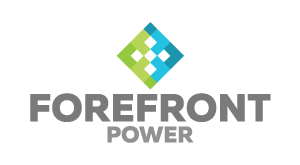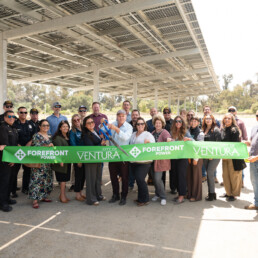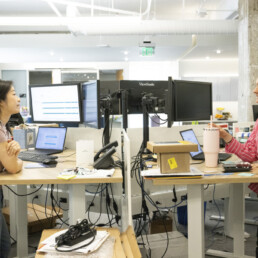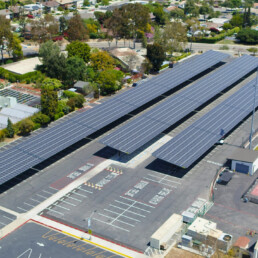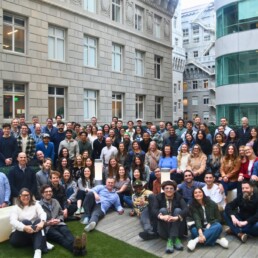We spoke to Senior Project Manager Erinne Davis to hear about the winding career path that led her to ForeFront Power and learn about her experience working closely with the City of Fresno to oversee the development of the largest commercial solar energy and storage system in the U.S.
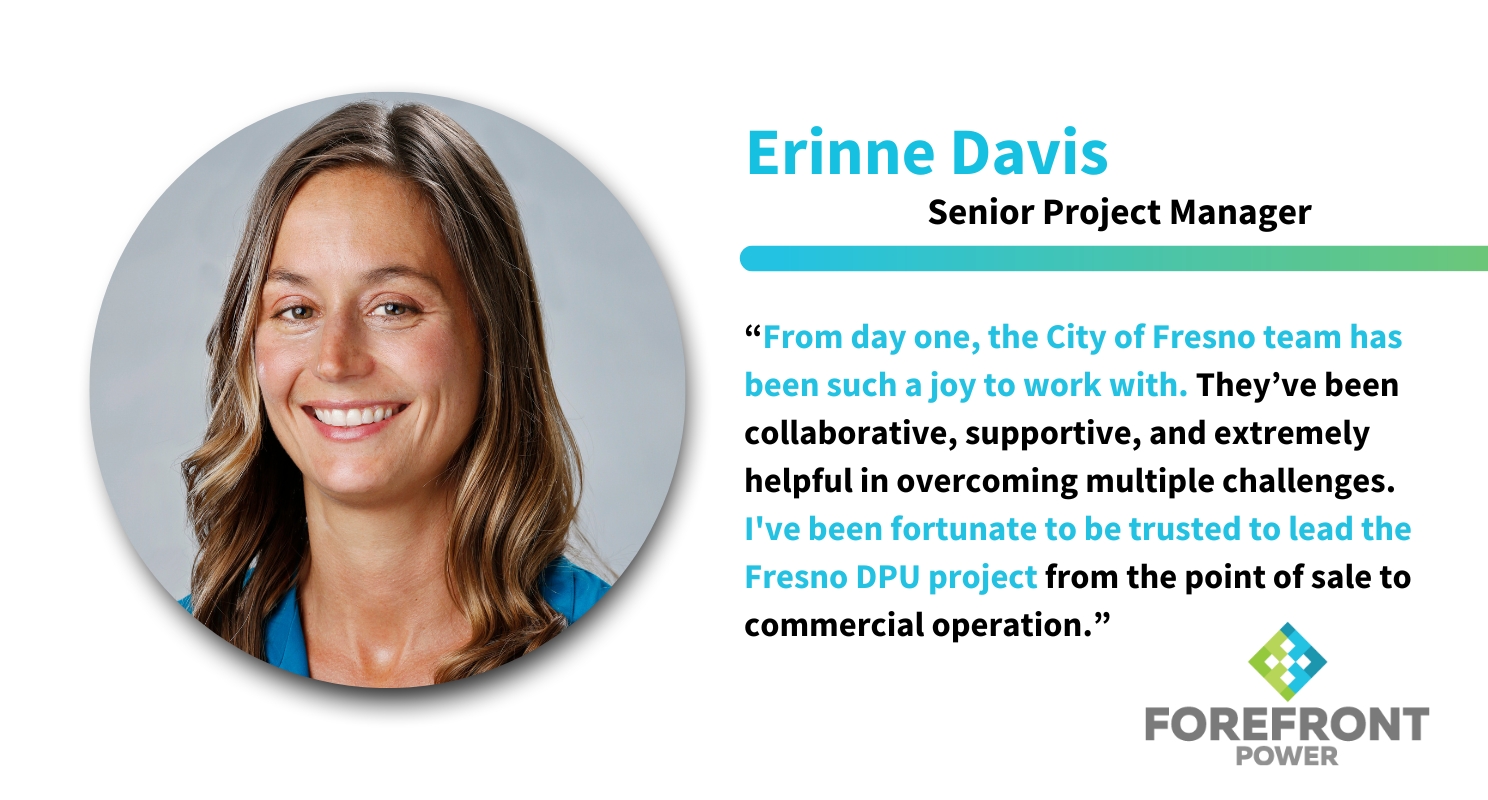
Where are you from originally?
ED: I was born in Salt Lake City and grew up in San Diego. I came to the San Francisco Bay Area to go to college and it felt like home.
Do you have any hobbies or anything you like to do in your free time?
ED: I love to play outside and just appreciate this beautiful planet we call home. That takes the form of surfing, bicycle riding, native plant gardening, foraging, stuff like that. I also love cooking for friends and being part of a vibrant neighborhood community here in the Outer Sunset in San Francisco. I’m always exploring new things, so I like to go on a culinary quest, learn how to make a new dish, and invite friends and neighbors over to share.
What inspired you to pursue a career in renewable energy?
ED: My third-grade teacher, Patti Lorman, initially sparked my environmental consciousness with daily open-forum discussions on topics like pollution, acid rain, and recycling. I would also say my upbringing taught me reverence, the capacity for awe, and the ability to recognize my place as a small part of something far more vast and grand. That attitude informed my personal choices and drew me towards this career path. It was a bit of a winding road, though.
What led you to ForeFront Power?
ED: After studying English and anthropology in college, I took an admin job at a residential remodeling firm in my hometown. Around 2009, the company launched a solar division, and I learned the ropes from a former SolarCity employee—everything from marketing to permitting, procurement, interconnection, installation, rebates, and O&M. That gave me a good baseline understanding of the solar business end-to-end and helped me get my foot in the door at a solar startup.
I landed a job at Sungevity and moved back to the Bay Area. From there, I joined Sun Light & Power in Berkeley, where I got into commercial project management and leadership, then Vista Solar in the South Bay. Eventually, I found my way to ForeFront Power, which, I have to say, is the best company where I’ve worked.
How has your role evolved during your time at ForeFront Power?
ED: I’ve been at ForeFront Power for a little over four years. When I started, they gave me an opportunity to learn their way of doing things for about 6 months before I took on people-management responsibilities. We slowly grew our team to include support staff like assistant project managers and project coordinators, as well as building out our capabilities for land and title and QA, roles that used to be part of the PM’s scope. I now manage a team of five people. Having just completed direct project management of the largest behind the meter project in the US, I’m excited for a new challenge. I’m looking forward to spending more time working on our process, training, and toolset improvements in the coming years.
What are some of the challenges that you face in your role and how do you overcome them?
ED: Implementing a solar and storage system behind an existing electrical system powering a customer’s facility can be much more challenging than just dropping in a new front-of-meter application. You have to integrate with the customer’s existing electrical controls scheme, accounting for any other generation sources like diesel backup generators, while also meeting the current utility protection and generation requirements. Sometimes this could involve upgrading aspects of the customer’s facility beyond what you initially scoped out. Plus, all the construction details need to be carefully coordinated with the facility for minimal impacts, such as power outages during the actual interconnection.
That being said, it’s delightful to collaborate with customers over the life of the project from conceptualization through energization. Clear communication and managing expectations are the best way to form strong customer partnerships where you tackle challenges together to get things done. It’s really one of the best parts of the job, forming those relationships over time, delivering a product that offers tremendous value, and that the customer appreciates. That payoff is so rewarding.
What is a memorable project you’ve worked on?
ED: There have been many over the past 15 years! But top of mind for me are the City of Fresno’s projects we did for its Department of Public Utilities. As an agricultural hub, Fresno has impressive water and wastewater infrastructure. It requires significant electrical power to operate these water treatment facilities. We developed solar and storage projects to offset significant amounts of their power consumption. The system we developed at the Fresno-Clovis Regional Wastewater Reclamation Facility is the largest commercial solar and storage behind the meter project in the United States, which is super exciting.
How was your experience working with the City of Fresno?
ED: From day one, the City of Fresno team has been such a joy to work with. They’re collaborative, knowledgeable, supportive, and have been extremely helpful in overcoming multiple challenges that could have killed the projects. We have an amazing project champion in Ann Kloose, who has been a dynamo in helping me figure out how to get through the various hurdles we faced.
I’ve been fortunate to be trusted to lead the project from the point of contracts being signed to where we are now, at commercial operation. In my role as the senior project manager, it was my responsibility to coordinate the work of the teams, both internal and external, to deliver the scope to quality, budget, and timeline expectations. I was kind of like the conductor of the orchestra.
Throughout the process, I developed tremendous respect for the work done by the public servants at the City, especially the folks that operate and maintain the water infrastructure. Their jobs are the kind of thing that the ordinary person never notices as long as they do it properly. It’s so easy to take for granted the fact that clean water comes out of our taps. And over the past four years working with the Department of Public Utilities I got to see a little window into how tirelessly they work to make the miracle of modern plumbing.
What impact do large solar energy and storage projects like the City of Fresno’s have on their communities?
ED: In the behind the meter business, the customer is benefiting from locking in a fixed rate for electricity that’s usually lower than the rate they currently pay to their power company. This this can have all kinds of benefits, especially for public institutions with rigid budget constraints. It offers predictability for their operating expenses and a reliable source of power.
In the case of the City of Fresno for example, the cost of electricity at the water treatment plants is one of the inputs for the rate that the residents of Fresno wind up paying for water and sewer. If we can provide a fixed cost of electricity in place for 25 years, that’s a huge benefit to the Department of Public Utilities in their heroic effort to control costs as much as possible for the City of Fresno residents paying for water and sewer. Then there’s also the fact that these projects create local jobs and opportunities for residents, as well as delivering clean air benefits to everyone.
What would you recommend to other municipalities or public agencies interested in developing their own renewable energy infrastructure?
ED: Solar and storage development can be a complex business, so look for a partner who’s experienced, transparent, and inspires trust. Make sure you have a strong internal champion for the projects, and that the project rationale is broadly understood and agreed upon by all the stakeholders. Construction itself can be a little messy and painful sometimes, no matter how well you plan it out. It’s important to make sure your facilities and on–the–ground staff are on board with the project and understand the benefits it will bring.
For municipal projects, if you can liaise in advance with the folks running your permitting department to make them aware of the project and get ahead of requirements, it can go a long way toward speeding up the process. Codes and standards are constantly changing, and sometimes up to interpretation, and this has a real impact on the cost of construction. That’s why it’s really helpful to have a strong working relationship with your permitting authorities so they can help you understand how to get your application addressed efficiently, with the scope and cost that the project can bear. That’s something municipalities are uniquely positioned to do in solar and storage development.
Do you have any advice or lessons learned you’d like to share with people who are pursuing careers in solar energy?
ED: For those interested in renewable energy, I always tell folks to consider a career in asset management or repowering, because every year my team builds more solar assets, all of which need to be maintained and monitored for many years to come.
Then more generally, my advice is to stay connected to your purpose. If you feel that your work has meaning and value, you can overcome the inevitable challenges in any hard job. Continue developing your skills and look for what you can learn from any situation. Let life surprise you and be open to where it goes. Don’t get too stuck on a fixed idea of where you want to go, but allow there to be more of an open field. Follow your curiosity!
Interested in learning more?
We would love to discuss how our solutions might be a fit for your organization. Contact one of our solar, storage, or e-mobility experts today:
